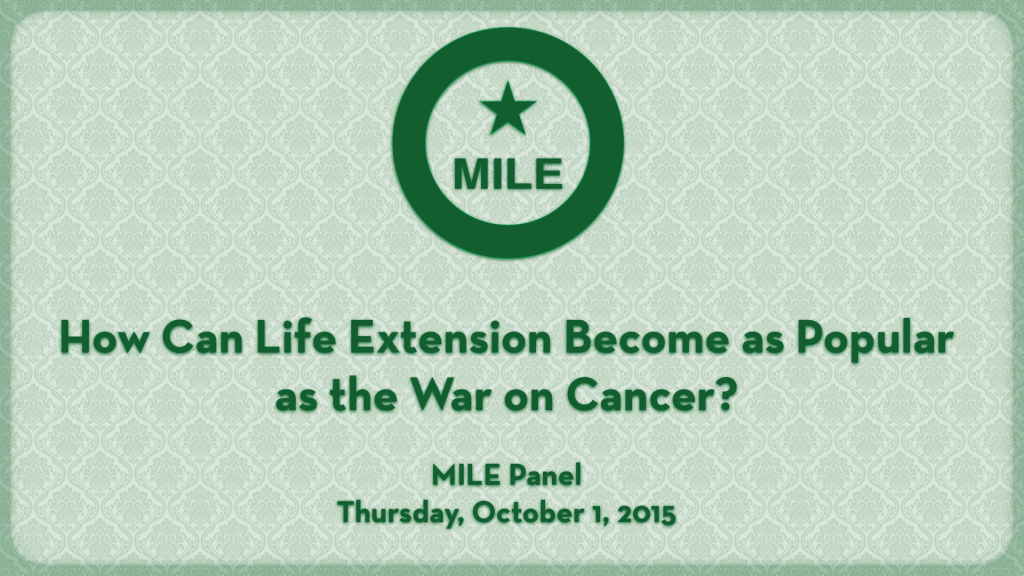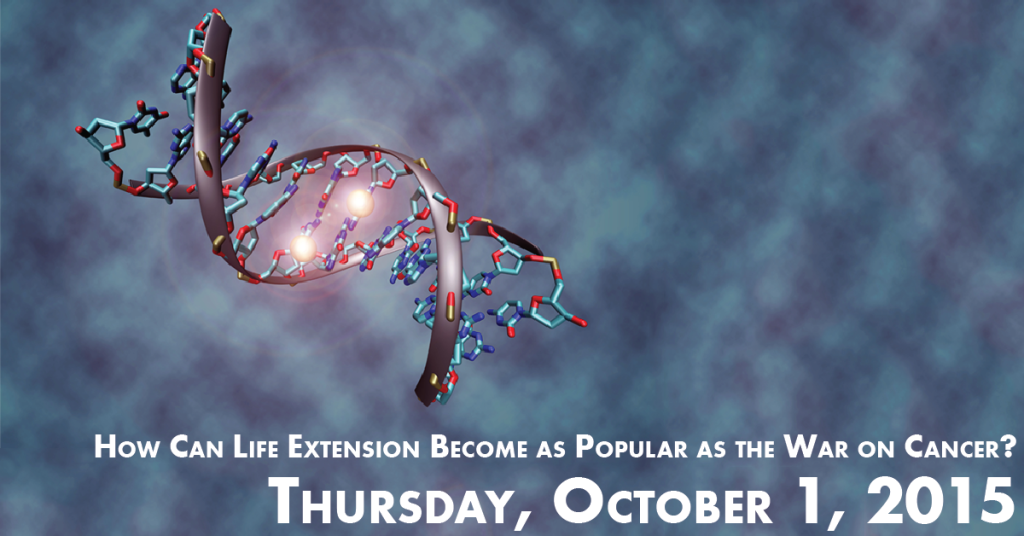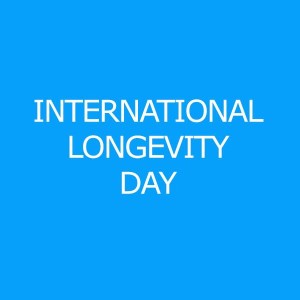There has been emerging a tradition by longevity researchers and activists around the world to organize events dedicated to promotion of longevity research on or around October 1 – the UN International Day of Older Persons.
The critical importance and the critical need to promote biological research of aging derives from the realization that tackling the degenerative processes and negative biological effects of human aging, at once and in an interrelated manner, can provide the best foundations to find holistic and effective ways for intervention and prevention against age-related ill health. Such an approach has been supported by scientific proofs of concept, involving the evidential increase in healthy lifespan in animal models and the emerging technological capabilities to intervene into fundamental aging processes. The focus on intervention into degenerative aging processes can provide solutions to a number of non-communicable, age-related diseases (such as cancer, heart disease, type 2 diabetes and neurodegenerative diseases), insofar as such diseases are strongly determined by degenerative aging processes (such as chronic inflammation, cross-linkage of macromolecules, somatic mutations, loss of stem cell populations, and others). This approach is likely to decrease susceptibility of the elderly also to communicable, infectious diseases due to improvements in immunity. The innovative, applied results of such research and development will lead to sustainable, economically viable solutions for a large array of age-related medical and social challenges, that may be globally applicable. Furthermore, such research and development should be supported on ethical grounds, to provide equal health care chances for the elderly as for the young.
Therefore it is the societal duty, especially of the professionals in biology, medicine, health care, economy and socio-political organizations, to strongly recommend greater investments, incentives and institutional support for the research and development dealing with the understanding of mechanisms associated with the human biological aging process and translating these insights into safe, affordable and universally available applied technologies and treatments.
October 1 – the International Day of Older Persons — provides the researchers and advocates an opportunity to raise these points and make these demands.
In 2013, events during or around that day – ranging from small meetings of friends to seminars and rather large conferences, alongside special publications, distributions of outreach materials (petitions and flyers) and media appearances – were held in over 30 countries, and in 2014 in over 20 countries. (Sometimes the events’ dates vary several days around October 1, or even through the entire month of October, designated as the “International Month of Older Persons” or the “International Longevity Month”, and sometimes the events are organized independently and without prior knowledge of other events, but they are all nonetheless unified by the common action and purpose.)
Following the collection of an impressive number of longevity promoting events worldwide in honor of that day, a general public appeal will be issued, both widely disseminated and addressed to relevant officials, both governmental and supra-governmental. Yet, the strength of the appeal will depend on the strength of all the individual events and actions.
Among the materials for discussion, distribution and promotion, one may use the position paper on the “Critical need to promote research of aging and aging-related diseases to improve health and longevity of the elderly population”, briefly describing the rationales, technologies and policies needed to promote this research. The position paper is available in 9 languages and can serve as a “universal advocacy paper” both for the grass roots discussions and promotions and for the outreach to officials: http://www.longevityforall.org/the-critical-need-to-promote-research-of-aging-around-the-world/. Also one may use in the preparation a presentation briefly listing some topics in longevity science promotion, such as the feasibility and desirability of achieving healthy longevity and public actions that can be taken to achieve it – http://www.longevityhistory.com/articles/ab7.php – or any other materials of your choice.
So far, events for that day – including meetings, publications and promotions – are already planned to be held around the world, in over 30 countries on 5 continents, including:
In the US, a conference will be held at the headquarters of the International Society on Aging and Disease (ISOAD), at the University of North Texas Health Science Center, in Fort Worth, Texas. This action will be endorsed and promoted by the US Healthspan Campaign (http://www.healthspancampaign.org/).
The Longevity Day action will also be promoted by the US Transhumanist Party, during their campaign tour that coincides with October 1.
Also in the US, online promotions will be held by the MILE campaign and by the Christian Transhumanist Association.

A special promotion will be done by LEAF – Life Extension Advocacy Foundation – via its crowdfunding platform for longevity research (http://www.lifespan.io/).
A fundraising action will be launched on that day for SENS Research Foundation by Fight Aging (https://www.fightaging.org/fund-research/).
In Israel, a seminar will be held in Bar Ilan University, by the Israeli Longevity Alliance. Toward that day, Israeli activists will also freely distribute an e-book on the history of longevity research (http://www.longevityhistory.com/).
In Moscow, Russia, a conference will be organized by the Russian Longevity Alliance. Another large conference will take place in Moscow, on the “Quality of Life of Older Persons”, supported by the Gerontological Society of the Russian Academy of Sciences, focusing on geroprotective substances and therapies.
In Gomel, Byelorussia, at the end of September, a conference will take place on the general subject of Radiobiolgy, at the Institute of Radiobiology of the National Academy of Sciences of Byelorussia, with a leading section on the biology of aging and longevity (“gerontological aspects of man-made factors”).
Another small conference will take place in New Delhi, India, organized by the Solutions For the Future, with the help of India Future Society, and ISOAD India.
A series of events is planned in Pakistan, by the Pakistan National Academy of Young Scientists and the Universities of Lahore and of Malakand. The newly formed Pakistan Aging Research Society (PARS) organizes an entire month long campaign, “Go for Life” – from September 1 until October 1 – to encourage physical activity of older persons.
In Rome, Italy, a conference will be organized by the Italian Transhumanist Association and the Italian Longevity Alliance.
Additional meetings and promotions are planned by the European Healthy Life Extension Society (HEALES) in Brussels, Belgium, including a Competition for the Best Short Film on Life Extension.
A conference on longevity/life-extension science will be held by the Waag Society – Do It Together Bio in Amsterdam, Netherlands.
In Germany, meetings will be held by two new officially registered political parties that emphasize the development of biomedical research in their programs: in Berlin, by the German Health Research Party and in Stuttgart by the German Transhumanist Party.
An online promotion (videoconference) in Spanish will be organized by the Venezuela Longevity Alliance (together with activists from across Latin America). A similar videoconference (to be recorded) in Portuguese will be organized for Brazil by the Brazil Longevity Alliance.
A pro-longevity documentary promotion will be done in Helsinki by Longevity Finland – Pitkäikäinen Suomi.
A meeting will be held in Stockholm, Sweden, by Aldrandefonden/Svenska Livsförlängningssällskapet SLFS – Swedish Life Extension Society.
In the UK, the London Futurist community will celebrate longevity research as a part of a discussion of emerging technologies in London.
In Larnaca, Cyprus, the ELPIS Foundation, together with the local gerontological community, will hold a seminar “Health in Older Life” and a local TV show in honor of that day.
In Perth, Australia, a meeting will be held by the “Healthy Longevity Philosophy” society. Another promotion will be done by Science, Technology and the Future society in Melbourne, Australia.
In Kiev, Ukraine, a seminar will be held on behalf of the Kiev Institute of Gerontology of the Ukrainian Academy of Medical Sciences.
In Beijing, China, a meeting will be organized by the Technium community.
In Uganda, the Kasese Freethinkers Sports Academy will educate about the connection between physical activity and longevity.
A mini-seminar will be held in Lekki, Lagos, Nigeria, by Longevity Nigeria group.
In Romania, a conference will be held at Äna Aslan National Institute of Gerontology and Geriatrics, in Bucharest, toward the end of October, with earlier promotions.
In Vietnam, Hanoi, the Vietnam Public Health Association will hold a conference on the Mental Health of the Elderly, emphasizing biomedical research on neurodegenerative diseases.
In Singapore, a seminar on biology of aging will be organized at the National University of Singapore. This will precede a large Biology of Aging Conference organized by the Singapore Immunology Network (A*Star) – not “officially” a part of the “Longevity Day” events, but perhaps of the “Longevity Month.”
At about the same time, the 10th Asia / Oceania Congress of Gerontology and Geriatrics 2015 for “Healthy Aging Beyond Frontiers” will take place in Chiangmai, Thailand, including sections on biology of aging.
In Paris, France, a seminar will be organized at the Biopark Cancer Campus, University Paris Sud.
In South Korea, the Korean Branch of Solutions for the Future will organize a meetup in Seoul.
In Switzerland, Zurich, the Swiss Longevity Alliance will have a presentation on longevity research. This will shortly follow a large international symposium on geroprotectors in Basel.
In Poland, the Warsaw University Students Association will support the organization of a discussion on life extension science.
In Canada, at Huntington University, an event will be held by the Canadian Institute for Studies in Aging (CISA). In Alberta University, Canada, a special discussion on Technology and the Future of Medicine will be dedicated to that day.
In Iran, a study group will be conducted in Tehran on behalf of the Iran Longevity Alliance: http://www.iranlongevity.com/.
Yet another study group will be held in Cairo, Egypt, by the Egypt Longevity Alliance: http://www.egyptplus.org/.
And yet another free discussion of longevity science will take place in Tirana, Albania – the first longevity research activism event in the country.
In Bulgaria, events toward the International Longevity Day will start earlier in September with a conference in Ravda, organized by the University for National and World Economy, Department of Management and BASAGA – Bulgarian Academic Simulation and Gaming Association, including a section on Futurism, Transhumanism and Longevity, and continuing up to the date itself with more live and online discussions and publications and a special appeal in honor of that day.
In Tokyo, Japan, Exponential Technologies Institute will hold a meetup on longevity science in the framework of Tokyo-Singularity-Meetup.
A meeting will be held in the National Library in Tbilisi, Georgia, by activists of the Georgian Longevity Alliance, including presentations on the development of longevity science in Georgia and the world, and debates.
More events and expressions of support are expected to be initiated in the very near time in different countries.
Please add your support and more events and publications for this initiative! If you would like to get involved, please let know!
You are also welcome to promote this initiative on social media:
https://www.facebook.com/events/1017229998296364/
https://www.facebook.com/LongevityDay
Preparations for the next year’s International Longevity Day – October 1 – already started as well. The next global conference of the International Society on Aging and Disease (ISOAD) will take place in Stanford on October 1-2, 2016. The topics will range from interventions for longevity through stem cell research, genetics and systems biology of aging, to public support for aging research. The submission of abstracts and proposals is already started and welcome. And a conference is being planned in Brussels, for September 29-October 1, 2016, by the European Healthy Life Extension Society – Heales.
Hopefully, thanks to these and many other events, in this year and in the years to come, the importance of biological aging and longevity research will gradually become a strong theme of the international healthcare agenda, for the elderly and for the entire population.
Ilia Stambler, PhD.
Outreach coordinator. International Society on Aging and Disease (ISOAD)
http://isoad.org/
ilia.stambler@gmail.com
Thank you!
Ilia Stambler, Ph.D. is an IEET Affiliate Scholar, researcher at Bar-Ilan University, Israel, and activist at the International Longevity Alliance. He is author of A History of Life-Extensionism in the Twentieth Century.
He studied biomedical engineering at the Moscow Polytechnical Institute, biology at the Technion, Israel Institute of Technology, and earned his MA in English literature from Bar-Ilan University. He earned his Ph.D. at the Department of Science, Technology, and Society, at Bar-Ilan University. His thesis subject, and his main interest, is the History of Life-Extensionism in the Twentieth Century.
In addition, Ilia authored Life extension — a conservative enterprise? Some fin-de-siècle and early twentieth-century precursors of transhumanism, Demonstration for Radical Life Extension in Tel Aviv, and Heroic Power in Thomas Carlyle and Leo Tolstoy, and coauthored Breast cancer detection by Michaelis–Menten constants via linear programming, and Comparative analysis of cell parameter groups for breast cancer detection. Read the full list of his publications!
He speaks Hebrew, English, Russian, German, and Yiddish. He is active in the Israeli chapter of Humanity Plus, the Israeli Society for the Biology of Aging, and the International Longevity Alliance.
Watch Demonstration for Radical Life Extension in Tel Aviv 5: Ilia Stambler. Read 10 Answers by Ilia Stambler. Visit his Facebook page. Read his Google+ profile and his LinkedIn profile. Read his blog Singularity | Life Extension | Transhumanism (Hebrew).






